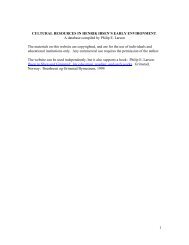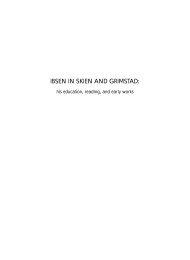- Page 1 and 2: 1 THE COLLECTED POEMS OF HENRIK IBS
- Page 3: 3 recollections. In The Lad in the
- Page 7 and 8: 7 O, blend but your plaining With s
- Page 9 and 10: 9 But shoots sprouted forth from th
- Page 11 and 12: 11 Round crumbled memorials gyratin
- Page 13 and 14: 13 Ha, you spot some earthly Miss,
- Page 15 and 16: 15 — But no, — by the shore all
- Page 17 and 18: 17 TO THE STAR (Dedicated to C:E:)
- Page 19 and 20: 19 Here may the heart find such con
- Page 21 and 22: 21 Wretched land! Their finest life
- Page 23 and 24: 23 To guard, in Parliament, its rep
- Page 25 and 26: 25 But were hope cheated, were it p
- Page 27 and 28: 27 Gently hum old songs, provide yo
- Page 29 and 30: 29 Kept from sight behind a pendant
- Page 31 and 32: 31 The dawning of my life on the fi
- Page 33 and 34: 33 True, there’s many a little ma
- Page 35 and 36: 35 Nobly the tasks he sustained. So
- Page 37 and 38: 37 MOONLIGHT MOOD Wanly shines the
- Page 39 and 40: 39 And that contending is its fines
- Page 41 and 42: 41 The one fares in the cause of pr
- Page 43 and 44: 43 7 I’m thinking of the legend o
- Page 45 and 46: 45 And I rushed the trap I’d fash
- Page 47 and 48: 47 THE SWAN When the mist autumns b
- Page 49 and 50: 49 Yes, indeed! King Christian’s
- Page 51 and 52: 51 From there it sarcastically glow
- Page 53 and 54: 53 Full many a grieving soul has fo
- Page 55 and 56:
55 The fiddle stops and to their gr
- Page 57 and 58:
57 In wondrous dreaming visions I t
- Page 59 and 60:
59 Yes we, a watch eternal, Shall l
- Page 61 and 62:
61 for your backing so far and good
- Page 63 and 64:
63 Poured from a horn of silver Fin
- Page 65 and 66:
65 Then must the speedy charger Sho
- Page 67 and 68:
67 She was no second Freia, All bri
- Page 69 and 70:
69 “But though my brothers perish
- Page 71 and 72:
71 And Dag sets out for Braalund, A
- Page 73 and 74:
73 On Idavold King Helge Strives we
- Page 75 and 76:
75 So that its rich, exuberant acco
- Page 77 and 78:
77 “He thought that your tears we
- Page 79 and 80:
79 Engrave themselves so deep in ou
- Page 81 and 82:
81 Far beyond the billows buried. T
- Page 83 and 84:
83 It seemed to me the plan compose
- Page 85 and 86:
85 Ulrikken, the highest of the mou
- Page 87 and 88:
87 So that my poor little flower sh
- Page 89 and 90:
89 “No, just the sere, the wind-f
- Page 91 and 92:
91 VIII For you must not forget: in
- Page 93 and 94:
93 And all my fair flowers, they pe
- Page 95 and 96:
95 God knows there were pictures en
- Page 97 and 98:
97 XXII My demon visits me by day a
- Page 99 and 100:
99 Then you’ll have felt your lip
- Page 101 and 102:
101 When epic shield-to-shield fora
- Page 103 and 104:
103 A thought that in a forty-year-
- Page 105 and 106:
105 FOR THE TENTH ANNIVERSARY OF
- Page 107 and 108:
107 At every sweet word received, S
- Page 109 and 110:
109 GREETINGS to HIS ROYAL HIGHNESS
- Page 111 and 112:
111 SONG preluding SHIP’S MASTER
- Page 113 and 114:
113 AT THE ANNIVERSARY of THE 22 ND
- Page 115 and 116:
Written to Susannah Thorensen in 18
- Page 117 and 118:
117 Ibsen was appointed artistic di
- Page 119 and 120:
119 Look towards the whole, not fra
- Page 121 and 122:
121 A score of turrets to the sky R
- Page 123 and 124:
123 Burns where the rudder races, S
- Page 125 and 126:
125 “There I am safe and there I
- Page 127 and 128:
127 Brows broke in that contention,
- Page 129 and 130:
129 SONG at THE DEDICATION OF THE N
- Page 131 and 132:
131 I’ve breathed elegiacal frost
- Page 133 and 134:
133 Like some blood-boltered child
- Page 135 and 136:
135 Will seek her for their own Ane
- Page 137 and 138:
137 And the old man, lone again, St
- Page 139 and 140:
139 PROLOGUE, delivered in the Norw
- Page 141 and 142:
141 Yes, and what’s worst is, —
- Page 143 and 144:
143 Of our songster-faring, songste
- Page 145 and 146:
145 No, royal Copenhagen, when all
- Page 147 and 148:
147 That at last you must have died
- Page 149 and 150:
149 Thue, a Norwegian grammar schoo
- Page 151 and 152:
151 Her bosom rose and fell. Now sh
- Page 153 and 154:
153 Snug lodging for all that. And
- Page 155 and 156:
155 Snow-glare makes a better showi
- Page 157 and 158:
157 He had heard my every wordless
- Page 159 and 160:
159 But thanks for your kind intent
- Page 161 and 162:
161 Seemed to beckon me so near. Oh
- Page 163 and 164:
163 Deep its furrows In the greybea
- Page 165 and 166:
165 Yes, should the need to fend th
- Page 167 and 168:
167 ON THE DEATH OF J. L. HEIBERG N
- Page 169 and 170:
169 And then there were few who’d
- Page 171 and 172:
171 The smallest cutter that he cou
- Page 173 and 174:
173 An east wind was rising, so Eng
- Page 175 and 176:
175 Then cried Terje Vigen: “You
- Page 177 and 178:
177 He waved his sou’wester and s
- Page 179 and 180:
179 Places I visited, where I had d
- Page 181 and 182:
181 No glimpse of the waters flowin
- Page 183 and 184:
183 Dare in your song ring loudly.
- Page 185 and 186:
185 Then, half-mast, it drooped and
- Page 187 and 188:
187 labour-guider, work-provider, S
- Page 189 and 190:
189 SONG at THE STUDENTS’ RETURN
- Page 191 and 192:
191 The bee, ever loyal, resumed hi
- Page 193 and 194:
193 My dear — Ibsen originally wr
- Page 195 and 196:
195 In his mind youth’s spate was
- Page 197 and 198:
197 Through the brave, bald reach w
- Page 199 and 200:
199 In sunshine’s festive spell S
- Page 201 and 202:
201 POEMS ABROAD FROM THE DYBBØL D
- Page 203 and 204:
203 But just as the romp had reache
- Page 205 and 206:
205 But knowing prophets flocked th
- Page 207 and 208:
207 Written shortly after the assas
- Page 209 and 210:
209 The city lies below, half-veile
- Page 211 and 212:
211 and from the fence-post there
- Page 213 and 214:
213 eyes tightly closed, chilled th
- Page 215 and 216:
215 “Recovered though, her pace p
- Page 217 and 218:
217 “And there his finest masterp
- Page 219 and 220:
219 until it vanished in the steep
- Page 221 and 222:
221 no living soul encountered as t
- Page 223 and 224:
223 but just a hint of question was
- Page 225 and 226:
225 the voice’s right to sing for
- Page 227 and 228:
227 A chuckle from the priest, then
- Page 229 and 230:
229 he drew in breath like one who
- Page 231 and 232:
231 A host of memories began to roa
- Page 233 and 234:
233 The captain rose, — an old ma
- Page 235 and 236:
235 But at a sunbeam’s touch his
- Page 237 and 238:
237 “To church!” was shouted as
- Page 239 and 240:
239 Who’d shriek his throat sore
- Page 241 and 242:
241 one or another from the pallid
- Page 243 and 244:
243 up in the pulpit Brand was hear
- Page 245 and 246:
245 Then I revisited eighteen years
- Page 247 and 248:
247 sank that night till the predic
- Page 249 and 250:
249 BALLOON LETTER to a Swedish lad
- Page 251 and 252:
251 Memnon’s statue, stone coloss
- Page 253 and 254:
253 are like bits of broken friezes
- Page 255 and 256:
255 stooled beside the altar-flame.
- Page 257 and 258:
257 flag in black-white funeral gui
- Page 259 and 260:
259 yours would lead without a brui
- Page 261 and 262:
261 That was when my thanks were ow
- Page 263 and 264:
263 Thus it is mind’s eye will se
- Page 265 and 266:
265 of your substance, rich and fre
- Page 267 and 268:
267 They flocked to a flag that sho
- Page 269 and 270:
269 round North Cape’s wall, east
- Page 271 and 272:
271 a cloudy torpor that frustrates
- Page 273 and 274:
273 spread abroad its shroud of dar
- Page 275 and 276:
275 slack orders slackly piped —
- Page 277 and 278:
277 she has loved through life, a l
- Page 279 and 280:
279 FAR DISTANT Our youth will soon
- Page 281 and 282:
Munich, 2 nd June 1875 281 The poem
- Page 283 and 284:
283 might find it by raking and tur
- Page 285 and 286:
285 Prologue for the Norwegian Thea
- Page 287:
287 Gone! 203 A Swan 203 The Gulley






